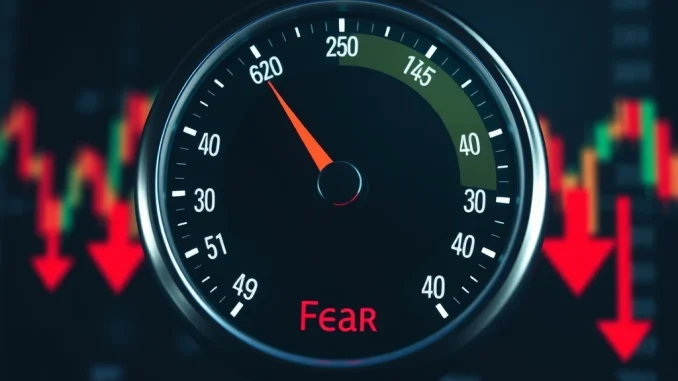
The cryptocurrency market, known for its volatility, often operates on a rollercoaster of emotions. One key indicator that attempts to capture this emotional landscape is the Crypto Fear and Greed Index. Recently, this index has taken a significant dip, sending ripples of caution across the crypto sphere. Let’s delve into what this means for you and the broader market.
What is the Crypto Fear & Greed Index and Why Does it Matter?
Imagine trying to gauge the overall mood of the crypto market. Is everyone optimistic and buying, or are they panicking and selling? That’s precisely what the Fear and Greed Index aims to do. It’s a tool designed to measure market sentiment, indicating whether investors are feeling greedy (expecting prices to rise) or fearful (anticipating price drops).
Why should you care about this index? Because market psychology plays a huge role in crypto price movements. Extreme greed can signal a market bubble, suggesting a potential correction is on the horizon. Conversely, extreme fear can indicate that prices might be oversold, presenting potential buying opportunities. Understanding the prevailing sentiment can give you a valuable edge in navigating the crypto markets.
The Crypto Fear and Greed Index, provided by Alternative.me, operates on a scale of 0 to 100:
- 0-24: Extreme Fear – This zone often suggests that investors are excessively worried. It can be a sign that the market is undervalued.
- 25-49: Fear – Indicates that fear is the dominant emotion in the market.
- 50-75: Greed – Signals that greed is becoming prevalent, and investors are getting bullish.
- 76-100: Extreme Greed – Suggests excessive optimism, which could be a sign of an impending market correction.
Think of it like a weather vane for the crypto market’s emotional climate. It doesn’t predict the future, but it gives you insights into the current prevailing winds of sentiment.
Breaking Down the Current ‘Fear’ Reading: What’s Driving Market Fear?
As of April 14th, the Fear and Greed Index stands at 31, a notable 14-point drop from the previous day. This firmly places the index in the ‘Fear’ zone. But what factors contribute to this reading and what does it truly signify?
The index isn’t based on guesswork. It’s calculated using a combination of six weighted factors, providing a holistic view of market sentiment:
- Volatility (25%): Measures the current and maximum drawdowns of Bitcoin, comparing it with the average values over the last 30 and 90 days. High volatility often breeds fear.
- Market Momentum/Volume (25%): Compares the current market momentum and volume to the 30 and 90-day averages. Strong momentum can indicate greed, while weak momentum might suggest fear.
- Social Media (15%): Analyzes sentiment on social media platforms, particularly Twitter, in relation to Bitcoin. Negative sentiment contributes to fear.
- Surveys (15%): Conducts weekly crypto polls to gauge investor sentiment directly.
- Bitcoin Dominance (10%): Measures Bitcoin’s dominance compared to the rest of the crypto market. Increased Bitcoin dominance can sometimes indicate a ‘flight to safety’ during fearful times.
- Google Trends (10%): Analyzes Google Trends data for Bitcoin-related search queries. Surges in searches like “Bitcoin crash” can indicate fear.
The recent dip to 31 in the Crypto Fear and Greed Index suggests a weakening of overall market confidence. Several factors could be at play, such as broader economic uncertainties, regulatory concerns, or simply market corrections after periods of growth. It’s crucial to remember that market sentiment is dynamic and can change rapidly.
Navigating Market Fear: Is it Time to Panic or Strategize?
Seeing the Fear and Greed Index in the ‘Fear’ zone can be unsettling, especially for newer crypto investors. However, it’s essential to resist emotional reactions and instead approach this as an opportunity for strategic decision-making. Here’s a balanced perspective:
Potential Challenges of Market Fear:
- Panic Selling: Fear can trigger impulsive selling, potentially leading to losses if assets are sold at market bottoms.
- Market Downturns: Sustained fear can contribute to prolonged market corrections or even bear markets.
- Investment Hesitation: Fear can prevent investors from entering the market even when potentially lucrative opportunities arise.
Potential Opportunities in Market Fear:
- Buying Low: As the adage goes, “buy when there’s blood in the streets.” Fear can create buying opportunities for assets at discounted prices.
- Long-Term Accumulation: Periods of fear can be ideal for long-term investors to accumulate their favorite cryptocurrencies at lower prices.
- Due Diligence Focus: Market downturns provide a good time to reassess your portfolio, research projects, and strengthen your investment strategies.
Actionable Insights: How to Use the Fear & Greed Index in Your Crypto Strategy
The Crypto Fear and Greed Index is a valuable tool, but it should be used in conjunction with other forms of analysis and your own investment strategy. Here are some actionable insights:
- Confirmation, Not Sole Indicator: Don’t rely solely on the index for trading decisions. Use it to confirm your own analysis and market observations.
- Context is Key: Consider the broader market context. Is the fear driven by a specific event or a general market cycle?
- Long-Term vs. Short-Term: The index can be more useful for identifying potential long-term buying opportunities during extreme fear, rather than precise short-term trading signals.
- Combine with Technical and Fundamental Analysis: Integrate the index with technical chart analysis, fundamental project research, and on-chain metrics for a well-rounded approach.
- Manage Risk: Regardless of the Fear & Greed Index reading, always practice sound risk management principles, including diversification and position sizing.
Conclusion: Embracing Calculated Caution in Crypto
The recent drop in the Crypto Fear and Greed Index to 31, firmly within the ‘Fear’ zone, serves as a reminder of the inherent volatility and emotional swings in the cryptocurrency market. While a ‘Fear’ reading might seem alarming, it’s crucial to understand that it’s simply a measure of current market sentiment, not a predictor of inevitable doom.
Instead of succumbing to panic, savvy crypto investors can use this information to their advantage. Market fear often presents opportunities to acquire assets at more favorable prices and to solidify long-term investment strategies. By understanding the factors driving the index and incorporating it into a broader analytical framework, you can navigate the crypto markets with greater confidence and make more informed decisions, even when Bitcoin fear or wider crypto sentiment seems to dominate. Remember, in the world of crypto, informed caution can be your greatest asset.



